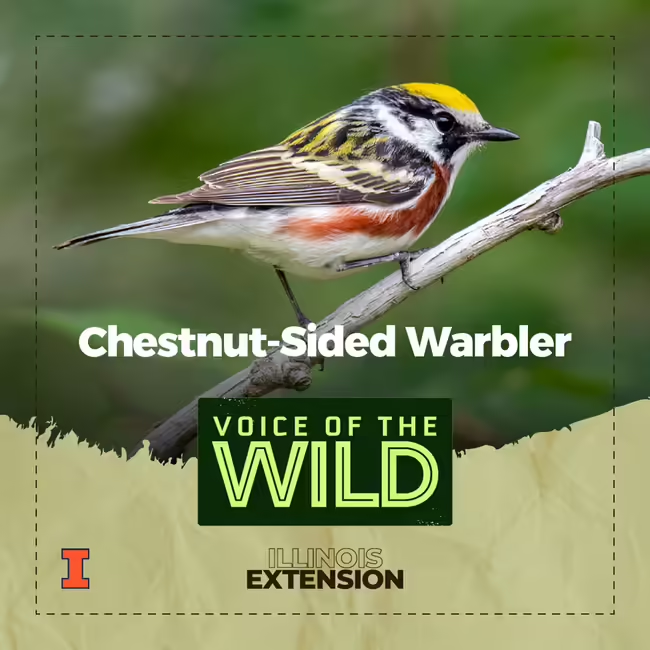
Episode Number
53
Episode Show Notes / Description
Chestnut-sided warbler (Setophaga pensylvanica).
A colorful warbler that’s “pleased to meet you.”
Do you want to learn more bird songs, frog calls, and insect noises? Join Voice of the Wild every Friday to explore a new wild voice. We’re available on most podcast platforms, including Apple Podcasts, Spotify, and YouTube.
- Subscription links Here
- Subscribe to the Newsletter
- Listen online on our Homepage
The following Cornell Lab | Macaulay Library recordings were used in this episode:
- Chestnut-sided warbler song by Geoffrey A. Keller (ML509242)
- Chestnut-sided warbler song variation by Matthew D. Medler (ML509241)
- Chestnut-sided warbler call by Robert C. Stein and Eugene Morton (ML509245)
- Yellow warbler song by Mike Andersen (ML509228)
Sources and more:
- https://www.allaboutbirds.org/guide/Chestnut-sided_Warbler
- https://www.audubon.org/field-guide/bird/chestnut-sided-warbler
- Dobson C, Kassenbaum D, Oehmke D, et al. 2023. Field guide to hotspots and birds in Illinois. Champaign-Urbana: Scissortail LLC.
- National Audubon Society videoguide to the birds of North America. 2004. Fullscreen. Carrboro, NC: Godfrey-Stadin Productions.
- Peterson RT, Peterson VM. 1980. A field guide to the birds : a completely new guide to all the birds of eastern and central North America. Fourth edition, completely revised and enlarged. Boston: Houghton Mifflin Company (The Peterson field guide series ; 1).
- Sibley D. 2016. Sibley birds East : field guide to birds of eastern North America. Second edition. New York: Alfred A. Knopf (Field guide to birds of eastern North America).
- Stokes DW, Stokes LQ. 2004. Stokes Field Guide to Warblers. 2nd ed. New York: Little, Brown (Stokes field guides).
Transcript
This is Illinois Extension’s Voice of the Wild. A new wild voice in just a moment, so find someplace quiet, take a deep breath, and enjoy.
This warbler tends to shy away from big, healthy forests when choosing a breeding site. Instead they like scrubby, early-succession woods, very similar in structure to the kind of forest growth that comes from too many invasive species and not enough stewardship. That kind of forest is (unfortunately) very common today. As a result, this bird is the exception that proves the rule; one of the few warblers whose numbers have likely grown since the pre-colonial era.
While their success is the result of degrading forest health, they’re nonetheless a beautiful and unique bird; one with plenty of gestalt; not only from their unique coloration; chestnut flanks in the spring and a lemon-lime cap in the fall, but also from the way they goes about their business; tending to hold their tail up and wings drooped. They’re a great warbler for beginners trying to learn the complex world wood warbler ID; once you learn this one, it’s easy to separate them out from the rest of the crowd.
This is the chestnut-sided warbler (Setophaga pensylvanica) from the family of the wood warblers, parulidae
The chestnut sided warbler is said to be “pleased pleased pleased to meet you”. Though they’ll sometimes sing small variations of this mnemonic. Pause. The chestnut’s song and call can sound somewhat similar to the yellow warbler, though I think the chestnut has a somewhat different cadence and sounds a little less saccharine overall. Briefly, here’s a comparison between the yellow and chestnut sided warblers, first the yellow and now the chestnut. Altogether now, here’s the chestnut sided warbler again.
Thank you to the Macaulay library at the Cornell lab for our bird sounds. And thank you for tuning in to learn a new wild voice with Illinois Extension.
This warbler tends to shy away from big, healthy forests when choosing a breeding site. Instead they like scrubby, early-succession woods, very similar in structure to the kind of forest growth that comes from too many invasive species and not enough stewardship. That kind of forest is (unfortunately) very common today. As a result, this bird is the exception that proves the rule; one of the few warblers whose numbers have likely grown since the pre-colonial era.
While their success is the result of degrading forest health, they’re nonetheless a beautiful and unique bird; one with plenty of gestalt; not only from their unique coloration; chestnut flanks in the spring and a lemon-lime cap in the fall, but also from the way they goes about their business; tending to hold their tail up and wings drooped. They’re a great warbler for beginners trying to learn the complex world wood warbler ID; once you learn this one, it’s easy to separate them out from the rest of the crowd.
This is the chestnut-sided warbler (Setophaga pensylvanica) from the family of the wood warblers, parulidae
The chestnut sided warbler is said to be “pleased pleased pleased to meet you”. Though they’ll sometimes sing small variations of this mnemonic. Pause. The chestnut’s song and call can sound somewhat similar to the yellow warbler, though I think the chestnut has a somewhat different cadence and sounds a little less saccharine overall. Briefly, here’s a comparison between the yellow and chestnut sided warblers, first the yellow and now the chestnut. Altogether now, here’s the chestnut sided warbler again.
Thank you to the Macaulay library at the Cornell lab for our bird sounds. And thank you for tuning in to learn a new wild voice with Illinois Extension.